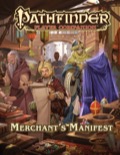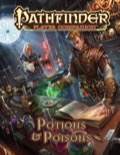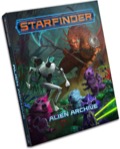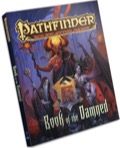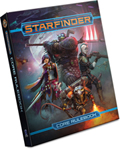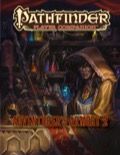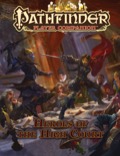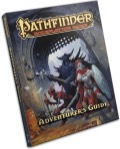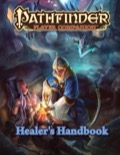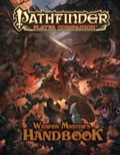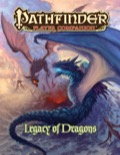Sign in to create or edit a product review. Basically Adventurer's Armory 3In comparison to the Adventurer's Armory 2, which I was more cool about, this book recaptures that feeling of a treasure box of neat and interesting items. Attack Badger Plush? Check. Parasitic rebreather fish? Check. Mechanisms powered by alchemical heat rocks? Check. Candles that also double as food? Check. The only gripes I have with the book are relatively minor and in no real way detract from the material in the book itself (apart from the Paladin archetype, which trades out a bit too much power for very minor boons). Definitely worth a read for all the interesting ideas the book brings out. Should be Drugs and DrinksI'm going to say right now, this book has no major game-changers for potions or poisons. The book is titled Potions and Poisons, but unfortunately this book has very little that really changes the game for those two types of items. Potions are by far the least explored part of this book, consisting of four feats total (of which only one will probably see any use in a game), a few pretty great potable versions of spells, a fairly lackluster Alchemist archetype, and a two-page spread listing spells that already exist and can be made into potions. Instead of anything useful, there's just two pages of effectively pointless filler, and not even particularly useful filler since most people work backwards when selecting potions (choose an effect then find the appropriate spell) instead of choosing from spells on a list, a list which isn't complete and even if it was would cease to be complete the moment a new 0-3rd level spell is released. Poisons get a somewhat better showing, though still lacking. All the poison-using feats are racial feats, as are half of the poison-using archetypes. It would be less of an issue if the races weren't uncommon races; they're tied to the Vishkanya, Nagaji, and Grippli, meaning they'll see much less use than if they were for the more common races. There's also the Toxin Codexer Investigator, which at first seems to be the big game-changer in poison use, allowing the Investigator to boost the power of poisons to a DC equal to their spell DCs. Unfortunately that archetype comes with two issues: first, the DC boosts are class-locked, so a Toxin Codexer and ONLY a Toxin Codexer gets the bonuses. It functions more similarly to the Alchemist's Toxicant or Eldritch Poisoner archetypes, except that the Toxin Codexer also gives up spell slots to function. The other issue is that the poisons also become level-locked. Arsenic is a 1st level poison for example, while Hemlock is 5th. The poisons not listed are up to GM approval, which means that some poisons (such as Tongue Twist, presented in this book) may simply be banned for use with the archetype if the GM feels that it's too useful, or may be set at such a high level that by the time it comes into use every monster is immune to ability score damage or flat immune to poisons. And it's unfortunate, because it means all future poison boosters might take that same form, or this might supplant any need to make real useful feats or abilities since everyone can now say "Want to poison things? Toxin Codexer is obviously the way to do it." The other sections of the book though are pretty solid. The talents and abilities listed for various classes make up for the overall weak showing in archetypes, and the Scorpion Bloodline gives a nice poison-based suite of abilities (though it functions based on a special scaling DC poison granted by the bloodline). The new elixirs are fantastic and make them into something more useful than just "drinkable Wondrous Items", like the Spirit Rush elixir which gives your villain a chance to always escape certain death, and even additional fleshcrafting elixirs. The new poisons are always fun to look at, since unlike the older poisons they focus more on strange and unique effects instead of ability score damage. The additional items are also pretty good, though most of the poisoner gear seems to be focused more on adding ways to poison a target instead of boosting the poison's power, and the anti-poisoner's gear is as would be expected, a number of items that grant bonuses to Fortitude saves and generally protect the wearer from being poisoned. However, the real stars of the book are the Tinctures and Drugs. Tinctures are a collection of weird alchemical not-potions that grant boons at some cost (in a way similar to the alchemical items from Ultimate Intrigue), but their effects are shockingly useful despite their cost and lack of real magic. Similarly the drugs are fantastic in this book, becoming items that players could see real use in and that actually give a person a reason to take them at risk of addiction. An old drug gives a minor ability bonus at the cost of ability damage and a risk of addiction. These give major really interesting bonuses at the same cost, which makes them infinitely more appealing. tl;dr Poisons are given not much support and there are no game-changers, potions are given even less. Everything else in the book is definitely worth it though. Like the core book, this is a fairly well executed book even if it isn't perfect. Unfortunately, unlike the core book, this is absolutely required material to play Starfinder. I can't really take off points for the book coming two months after the release of the game (though I will point out Starfinder is the only system to my knowledge to do that), but it's still not good planning for potential players. That point is moot at this point though. The book itself has a good amount of imaginative monsters, ranging from gelatinous cubes made of devouring nanobot swarms to starship-sized Devils (who can also turn into starships), and a shockingly large amount of monsters in the book are also statted as possible PC races, which is a nice surprise for any potential player who wants to be something really weird and out there, like a giant floating psychic brain. The book also has a number of quick building rules for monsters and encounters, which with a bit of practice should speed up on-the-fly adjustments for groups who need a bit more of a challenge. Unfortunately, the book is also very, very short. It clocks in at just over 160 pages total, under half of a normal Pathfinder bestiary. And, unlike Pathfinder, Starfinder doesn't have an expansive previous system it's based on to use for encounters. I have to assume that the book is short mostly due to an unfamiliarity with the Starfinder rules on the part of the writers, but given the extra two months between the book's release date and the core rulebook's release, the book shouldn't have been anywhere near this small, especially as the only real source of encounters currently available for the game. The small size of the book may not be an issue to everyone, but it IS an issue to be aware of, especially if buying the hardcover copy. Seen many many times before, but never in this formatMy two major points about this book are this: 1) It's almost entirely reprints, and 2) It's a campaign setting book. So for my first point, while I say it's a reprint, at least in this case it makes some degree of sense (though $45 for it really feels like you're being cheated out of your money, the $10 price is much more acceptable). Much of the evil deity material has been stuffed away in the backs of APs or in small segments of Campaign Setting books, so having a book which is more or less complete collection of those bits of information is useful. And even then, at least there's new bits of flavor text to go along with the entries, which makes it not a complete copy+paste job like much of the Adventurer's Guide. Still though, a lot of it (like 1/4-ish of the book) is reprinted boons. There are some new ones, which is nice, but the total amount of new material (including feats, magic items, boons, rituals, and monsters) is barely enough to fill a campaign setting book. Which brings me to my second point: that this is a campaign setting book masquerading as a core line rulebook. This I blame mostly on page limits, since I believe all the books are restricted to certain numbers of pages, and the amount contained in this book fills almost 300 pages with material. The thing is, probably 1/2 or more of that material is pure fluff. Lots of setting information about the Evil-aligned planes, tons of lore information about the various deities and demigods, and a 30 page "excerpt" from the book of the damned in hard-to-read writing font describing the lower planes again. If all the old material had been completely removed and some of the more verbose sections had been trimmed down, this would fit nicely into a campaign setting book called "Book of the Damned". Even just selling this directly as a campaign setting book would have fit perfectly, since it matches the format of things like Inner Sea Gods, but with a larger pagecount. But this book honestly is probably the least deserving of being put in the core line due to its content being almost entirely fluff. Adventurer's Guide, as much as I disliked that book, was at least full of options for players and fluff was second to that. Aquatic Adventures would be a better fit than this for a core line book. tl;dr It's a good buy for $10 if you want a collection of Evil deity boons and a smattering of new material, don't buy for $45. The review is fresh so it may take some time before the final result comes to light, but the initial reception is very positive. The Starfinder Core Rulebook is an excellent start, keeping some of the Pathfinder feel while finally breaking away from the chains that tied it to 3.5 and letting it experiment with new design and ideas. Almost everything is well-balanced, and thanks to the modular design of the classes, feats (which have finally gotten rid of massive prerequisite chains!), and equipment, new material can feasibly be added without strange interactions and long chains of requirements that make something nearly impossible to use effectively. Not everything is perfect of course. The Envoy is the major sticking point on that matter, and while it has some interesting ideas around using its actions to give boosts and buffs to allies, those buffs might be overtuned. Unfortunately we don't have enough material to make a complete judgement, but the bonuses may range between invaluable in combat to completely negligible depending on how the math shakes out. It feels a lot like the original Rogue: keep them around for skills and the occasional help in combat, but you don't miss much if they're not present and they don't work well alone. Other sections in the book, like Feats, feel a bit lacking too, but I imagine that's more due to space restrictions than design issues. Like Pathfinder, once the game has more material out (especially more material for the Envoy) and more room to breathe it'll be fantastic, but right now it's just an excellent start. Needed to be more adventurousFor the most part this is a very solid book. The equipment packages are a great idea for players who want to get started fast without hunting through pages of items for the prices of cheap equipment (and are a good value to boot), I want one of those waifu body pillows for the Butchering Axe, the Poppets are a great idea as cheap, easy-to-build, handy constructs, and I absolutely adore the new equipment tricks. There are also a number of reprinted items, but at least there's enough new material that it doesn't feel as egregious as when the Adventurer's Guide did it. However, a bunch of the stuff seems like it was toned down or otherwise weakened in the interest of playing it safe. The biggest examples of this are probably the Armor/Weapon Modifications that were included. The basic idea is great, giving some customization options to players who want to add new effects or shiny bells to their equipment, but the system needed more room to grow and display what it could do rather than two pages overall. Most of the armor modifications aren't worth the price for the modification because the effects seem almost nerfed by committee, like the modification which dazzles a creature once per day if they fail a (admittedly good) DC, or the one which has a chance of sickening a creature if they happen to be using power attack and their mother just called last night and complained about how much better their brother is doing as a monster in The Dragon's Crypt, and have they met any nice goblin girls yet? The weapon modifications are a bit better off, but most of the modifications are miniscule bonuses that could have been boiled down to some additions to the Weapon Design Rules (from Weapon Master's Handbook) and a note on how to attach those additions to already existing weapons. As much as I'd want those rules to be expanded and refined into something really worthwhile, they're most likely just going to be forgotten as a bunch of weak non-magical weapon "enchantments". It just feels... too toned down, in a way that's kind of hard to voice properly. Like the entire book was restrained, or the writers couldn't make a bunch of cool weird items for one reason or another. The first book had the feeling of being a treasure box of items that made your mind spin with the possibilities for each one. This one feels like a store shelf, where everything's been placed out for display in a very specific way, and you're just browsing for something that you want. tl;dr Not the best book, but it's still fairly solid and has some good ideas and new tricks. Surprisingly HeroicThis is not a well-titled book. When you think of a book with this title, you think of a middling to mediocre heavily flavor-focused book with at best some fluff archetypes that are kind of forgettable after a week or two. What you don’t expect is a whole host of really cool archetypes, flavorful items and abilities that hold up mechanically, and even new options for verbal duels of all things. Not everything’s a slam dunk of course, there’s a few less interesting or questionable archetypes scattered throughout the book (like the Paladin that trades out a bunch of stuff to basically become a Swashbuckler) but there’s also a bunch of really good archetypes included, like the Fighter archetype that gets Strength-based Combat Reflexes, and the Silksworn Occultist, a great archetype for the class that only gets better as it wears increasing amounts of bling. Definitely worth a look, especially for someone who wants a character that's regal and wants to show it in style. A Legacy Worth RememberingAfter the combination train wreck/dumpster fire that was Legacy of Dragons, I was completely prepared to write this book off as a part 2 to the Legacy of Trash. Consider my complete surprise, then, when I found that this book was not only good, it was great. Just about everything in here oozes with Fey style, and mechanically just about everything holds their own. The only notable exceptions are the Seducer Witch, which unfortunately falls into the realm of "surprise villain archetype" due to how its class features work based on seduction, and the First World Innovator Alchemist, which is one archetype that I'm still debating over. The rest of the book is rock solid though. Some sections are worth itIgnoring the fairly sizeable chunk of reprints, the book is fairly average. Some sections stand out more than others (The section on the Al-Zabriti is particularly good, and the Gray Maiden section is very well done), and it seems like the writers actually had a real interest in making something both flavorful and fun. Those sections really shine as something to read for, but other sections are completely lackluster, boring, or just bad. The sections for Hellknights and Magaambya, for example, might seem familiar to people reading through them, because most of those sections are completely reprinted material (apart from two archetypes in each which tend to meet a modicum of association with the section). The Aldori Swordlord section also sticks out as particularly bad, as the options contained within (which are about half new) just feel completely phoned in both flavor-wise and mechanically, as they’re all fairly poor options besides the Fighter archetype which is actually a reprint. And that brings up the connection to the Golarion lore, which was a major point of contention prior to the book’s release. This book honestly feels like a strike against tying the rules to Golarion proper for a few reasons. First, it affects the writer’s interest in the material. The gap between the good sections and the bad sections are night and day, and while future core books would benefit greatly from an attachment to the lore from an inspired writer, the sad fact is that it won’t always happen. That’s something that’s better left to the campaign setting line, since those books can become shorter and more focused on what the writer wants without having to split that focus on something that they find uninteresting, causing it to become lackluster as a result. Second, the focus on the lore seemed to cause this book to become filled with reprinted material or basic material in what looks like an attempt to fill empty space. Stripped of the Golarion lore, the section on Hellknights and Gray Maidens could have been combined into one mega section called “Faceless Enforcers” or something, which would have been able to share classes and options between the two (since there are thematic similarities). Instead of having to fill a specific quota of 10 pages of Hellknights (of which only 2 are filled) and 10 pages of Gray Maidens (which seems to have had to cut out a dozen good ideas), there would instead be 20 pages to share between the two of them which could be filled with feats and abilities that could benefit both groups, or similar groups in a non-Golarion game. tl;dr Minus the reprints the book is a solid middle ground, but the reprinted material (and even reprinted art? That just makes the book feel like a cashgrab) makes it less worth it. Tying it to Golarion lore, while possibly a benefit with the right material/writer matchup, does no favors to this book and instead seems to drag it down. At least it's only $10. Also, the book has some AP spoilers, which is something that should have been prefaced somewhere. Super Specific Monster Hunter's HandbookI think the best way to describe this book is "too focused". Not focused in the good way, where there's a strong thematic link between options and everything has a strong idea of what it’s supposed to accomplish, but focused in the same way Weapon Focus or Skill Focus is focused. Far too much of this book only applies against very specific creature types or situations (some of which you can even choose). Almost all the spells are either extremely situational or require you to specify a specific type of creature for the spell to work against, about half of the magic items and mundane equipment only functions against specific creatures chosen at the time of creation, and half of the archetypes become ineffective when not in a campaign that lets them fight very specific enemies. Even some of the options that aren’t super focused aren’t particularly great, like the Disciple of the Pike Cavalier which trades out their mount but for some reason still focuses super hard on charging with a lance/spear, and the vast majority of the feats which are either straight-up bad or just boring and not worth spending a feat on. Even the feats that SHOULD have been cool, like Dimensional Step-Up, completely falls flat outside of very specific circumstances. Tons of them function only if the monster attacking has a specific ability or uses a very specific tactic. Ironically, probably the best feats are the Focused Expertise feats which grant bonuses in every circumstance and grants an IMPROVED bonus against the chosen favored enemy type. Which is really how most of the options in the book should have functioned: grant a bonus that improves under a specific circumstance, not grant a bonus that only exists under a specific circumstance. And speaking of bonuses that only exist under a specific circumstance, let’s talk about the trophy rules. The basic gist is that, after killing a creature, you can take its parts and create items (that fit into magic item slots) that grant you bonuses to a number of stats, and the bonuses increase based on the CR of the killed creature. Sounds pretty great, right? I agree. Oh, also it’s two feats deep into a chain, the first feat of which is really useless unless you’re an Alchemist or can otherwise craft things at super speed before the parts you collect rot into worthlessness. And the trophies themselves only last for a number of days, with a scaling DC which means having something last for a week is high-end skill focus. And the trophies themselves only grant a bonus against creatures of the same type. And if you didn’t craft them yourself (such as killing the creature, giving the bits to the party Wizard to craft, and then putting them on) you gain a reduced bonus and the trophies rot after 24 hours. And, again, they take magic item slots, which means you’re going to have to fight to fit them plus your other gear. Thankfully Monstrous Crafter exists, which can combine trophies with existing magic items and even makes the trophies last forever, right? Wrong. Unlike before the trophy benefits now become 1/day for one minute instead of constant, and it’s 4-5 feats deep since you require Monstrous Crafter, Grisly Ornament, Harvest Parts, Craft Wondrous Item, and (if you’re a non-caster type which is the kind of character that would MOST BENEFIT from the trophies) you also need to take Master Craftsman. At that point it’s half of your feats (or 1/4 of your feats for a Fighter), which is a huge investment for a character to make. There are a few alright options, but it’s the minority in the book. Probably the most worthwhile thing is the Psychodermist, an Occultist archetype that can actually effectively use the incredibly underwhelming new trophy rules, but an entire book isn’t worth one archetype. Avoid this book. (Magic) Healer's/Supporter's HandbookThis book's kind of hard to get a perfect read on because it's so densely packed, but what I've been picking through seems average. There's a few interesting options such as the Angelfire Apostle that effectively adds a breath weapon to healing spells and the spell Balance of Suffering which allows you to heal one target at the expense of another's life force, or the Phoenix Feather which is just a Phoenix Down, or the Paladin stuff which is all pretty great. But a lot of the stuff just seems very bland at best. The Arcane Physician for example is probably the most "meh" thing in the book, since it's just a Wizard that gets healing spells. That's really about it. There's also a weirdly high amount of options dedicated to status suppression and miscellaneous support abilities instead of actual healing, such as the Sacred Attendant who gains the ability to boost Charisma checks. Also, most of the options in the book are caster-oriented. There are two non-caster archetypes (a lesser but unchained-friendly version of Monk of the Healing Hand and a Ranger that's okay at finding plants), and the Combat Vigor feats are more work than they're worth unless you're a Fighter with plenty of feats to spare to make them worthwhile, not to mention they're self-only unlike a wand of a cure spell. tl;dr, if you're expecting new uses for the Heal skill or new alchemical healing items, or feats and abilities that make even the least magically-inclined Barbarian into a somewhat viable out-of-combat healer, this isn't the book for you. If you're looking for new ways for your existing healer to heal more differently, then pick this up. So nice I bought it twiceI bought this book from my local game store some time ago and just now bought the PDF so I could have a copy on my tablet. This is, in my opinion, probably one of the best books Paizo has put out including other product lines such as the Core books and APs. It's chock full of interesting options for martial characters, especially the Fighter. The Fighter, which has traditionally been the most boring class in the game, got elevated to one of my favorite classes to tinker with thanks to this book alone. Not everything's a hit, like the weapon creation rules which are kind of funky and seem more like a tool to powergame weapon groups in weird ways, but they're minor enough issues or just not bad enough to detract from the book as a whole. Absolutely pick this book up, if for no other reason than to support this kind of content in the future. It's a hit only once every 1d4 roundsThere's a lot of little good things in this book, such as the section on Wyvarans (if you're into that), Draconic Heritage being a feat anyone can take and use, the variety of traits, both normal and racial, which can widely expand variety in characters, the addition of various dragon types for bloodlines and in new spells, and the flavorful new Oracle curse which requires you to wear bling or take minor penalties. The new Style feats are pretty alright too, although the only one I really have eyes for is Tatzlwyrm Style. Linnorm Style's base feat is alright but the higher level ones have an effect that only triggers if you would be knocked out (and the 3rd feat focuses on that), and Wyvern is some kind of Monk/Brawler-only Whip thing. But there's a heap of bad too. I'm particularly annoyed by the Dragonblood Chymist which trades out a ton of class features, and replaces them with worse class features. It's almost as if it was made by someone who isn't aware how the class actually functions, because every feature it grants is one that you could already get as a discovery in a better form. The Dragonheir Scion is similarly bad, because not only does it lack a caster level (meaning that the built-in Arcane Strike never powers up), it also requires the Fighter to replace "the bonus feat gained at 3rd/5th level", and since it's a Companion book it's likely that the poor Fighter will never be able to qualify for this archetype since it's unlikely to ever be fixed. The other archetypes, while not as obviously bad (besides the Sovereign Blade) are still a bit shaky, such as a Monk that gets Cha as their main stat, making it great for dips as a Sorcerer/Oracle (and even better as a Paladin going into Champion of Irori) but not so great when your Will save has been lowered. The Wyrmwitch is probably my favorite archetype in the book because of the hoard familiar which is both hilarious and flavorful, but if a few gold pieces go missing the Witch suddenly finds themselves unable to prepare spells. Drake Companions are also something that were hyped up, and they don't live up to the hype by any means. Imagine yourself riding your faithful dragon ally into battle, spearing foes from his back while he breathes torrents of flame before you take to the skies and fly off into the sunset. Riding isn't possible before level 9 for a Small rider, 13 for a Medium one, and takes 2 of the 5 available drake powers. Gaining a breath weapon is another one, although that's a 1/day low-damage glob until level 15 when it becomes a 3/day low-damage glob, at the cost of three total drake powers. And that's not including how you need to use a Diplomacy or Intimidate check just to get the Drake to do anything. Imagine if a Paladin had to really nicely ask the nebulous forces of good for a Smite, or if a Wizard had to threaten his spells just to make sure they actually targeted the right creatures, or if a Fighter had to bribe his sword to deal damage. A class feature with a mind of its own that in most cases is counter to your own agenda isn't a good class feature, and it's made worse by the fact that each archetype trades out massive numbers of features just to get a drake. tldr: Don't get it for the archetypes unless you're willing to put a lot of work in to make dragonriding work. Get it for the feats, traits, and spells, which are decent and make up the majority of the book. There might not be enough with just those for a given buyer though, so be warned. Thoughts several months later: Blood of the Beast released and included the "Feline" Wildsoul Vigilante natural course, which was an excellent idea which also opens the door for more similar archetypes (and archetype updates) in the future. Why am I bringing it up? Because this book would have been the perfect place for the very first one, with a Dragon natural course for Vigilantes. Instead we have the Dragonblood Chymist, which I am STILL mad about months after the fact. Edit 2: It's been two and a half years. I'm STILL mad about the Dragonblood Chymist. Edit 3: It's been almost 5 years. I'm STILL mad about the Dragonblood Chymist. |




